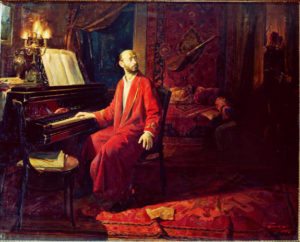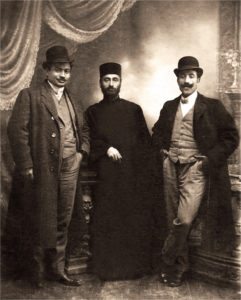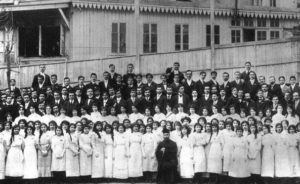Armenian had many great intellectuals but the role of Komitas in the history of Armenia, Armenian Church, and Folk music is vital. His art is a fascinating melting pot of traditional music.
Childhood
Soghomon Soghomonyan was an Armenian musicologist, priest, composer and singer, a. k. a Komitas. Soghomon came into the world on September 26, 1869, in Anatolia, Turkey.
His hometown was Koutina. His father Gevorg was a shoemaker but at the same time Gevorg composed songs and had a good and beautiful voice. The composer’s mother – Tagui was a carpet weaver and also had musical abilities.
In reality, Komitas didn’t have a joyful childhood. The boy became an orphan at the age of 11.
 He was a weak, pale boy. Komitas had poor clothes and slept on the cold stones of the laundry room. He sang perfectly and for that reason, people call him “a little vagrant singer”.
He was a weak, pale boy. Komitas had poor clothes and slept on the cold stones of the laundry room. He sang perfectly and for that reason, people call him “a little vagrant singer”.
Soghomon’s uncle adopted him. Soon Echmiadzin church took him in due to his beautiful voice and love towards Armenian Church music.
They selected him out of the other 20 orphans to study at the Seminary. As there were certain rules they didn’t let him speak Armenian and the boy spoke Turkish. Once he replied Catholicos Gevorg IV by saying “I don’t speak Armenian if you wish I will sing”. He sang an Armenian sharakan with his good voice but didn’t understand the words. No longer after that, he learned Armenian.
Education
Soon the church ordained Soghomon a monk. After graduating the seminary at the age of 25 they ordained him a priest and he took a new name “Komitas”.
In 1895 he left for Tiflis to study at the musical college and there he met the composer Makar Yekmalyan and changed his mind. Komitas started studying a course on harmony.
With the sponsorship of Armenian oil magnate Alexander Mantashyan, he went to Berlin and entered the private conservatory. Besides all of these, he also took private classes on singing and attended the lectures on General History and History of Music, Philosophy.
He gets an invitation from the International Music Association and upon the invitation, he had lectures devoted to the Armenian church and contemporary music in comparison with Turkish, Arabic and Kurdish music.
In 1899 he came back. In a short period, he radically changed music teaching methods, organized a small orchestra and improved performing the level of the choir. By visiting various regions of Armenia he wrote down thousands of Armenian, Kurdish, Persian and Turkish songs.
He studied Armenian folk and church melodies and worked on the opera “Anush”, which he started back in 1904. Soon a backward group of the church figures, gossip, and indifference of new leaders poisoned his life. They consider him a worldly man.
The conflict was so big that the priest sent a letter to the Catholicos where he begged him to release him and let him live quietly but his request remained unanswered.
Working Period
In 1910 he went to Constantinople. Komitas had many great ideas which were faced with the cold indifference of the local authorities. There he organized a choir of 300 men and called it “Gousan”. It was very popular. Armenians compose folk songs mainly by his concerto program.
He also acted as a soloist, conductor and wonderfully played flute and the piano. Many well-known musicians like Camille Sen-Sans, Claude Debussi, Vincent D’Andy, Gabriel Fore and much more fell in love with Komitas’ creative work.
In reality, Komitas could not find any contemporary thinking people who would help him fulfill his plans. The composer wrote “Patarag” and only men were in the chorus staff.
Final Years
In 1915, Armenian composer was arrested together with 235 outstanding Armenian writers, publicists, physicians, and lawyers. After the arrest, due to his friends, they deported him far in Anatolia where he became a witness of the brutal extermination of the nation’s bright minds.
 Being an Armenian Genocide witness and seeing massive killings of Armenians he had experienced a deep ineradicable impression on his soul; he suffered from traumatic neurosis. In other words, Komitas remained in seclusion from the world, he was sad and broken.
Being an Armenian Genocide witness and seeing massive killings of Armenians he had experienced a deep ineradicable impression on his soul; he suffered from traumatic neurosis. In other words, Komitas remained in seclusion from the world, he was sad and broken.
Soon his health was deteriorated and in 2016 he was put in a psychiatric hospital. He moved to Paris in 1919 and died there in 1935. People transferred his ashes to Yerevan and buried him in the Pantheon. Now the Pantheon is called by his name. Unfortunately, Turks destroyed most of his works.
The landmarks named after Komitas and movies about him;
-
The Yerevan State Musical Conservatory.
-
The central square of Vagharshapat.
-
Komitas Avenue, the main thoroughfare of Yerevan’s Arabkir District.
-
The writers’ and poets’ pantheon.
-
The Komitas Museum near to the Pantheon
-
Komitas – 1989 – Director: Don Askarian
-
Alter Ego – 2016 – Director: Vigen Chaldranyan
Yaşar Kurt’s striking resemblance to Komitas
In 2009 a famous Turk rock singer Yaşar Kurt came to Armenia for a concert. Once he entered a shop in Armenia and saw a CD with a picture of Komitas. Yaşar was surprised as the person in the picture looked exactly like him. He thought that it was him and argued with the seller. The workers of the shop told him that Komitas was a famous singer and composer.
Yaşar went back to Turkey asked his mother to tell him the truth about him. Soon it turned out that his ancestor was the survivor of the Armenian Genocide. And all his family and ancestors are also Armenians. Only now Yaşar understands why he wants to cry every time he hears Armenian songs.
Komitas Vardapet is a beginning without any limitations. It is important to realize that anything we do, anything we play connected with him as he established a new way of musical thinking. His musical art has a big value, it is the highest level of the Armenian school of composition.









Leave a Comment